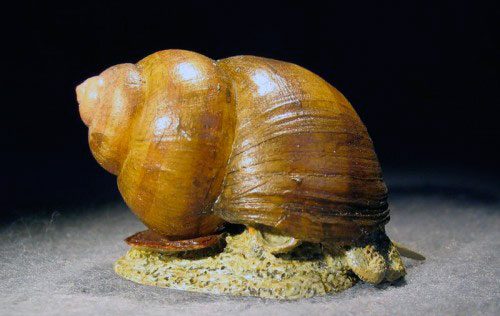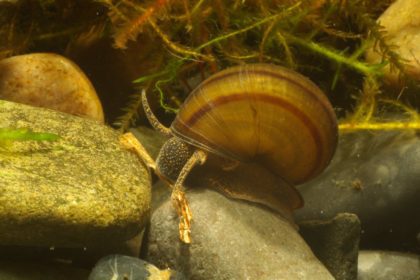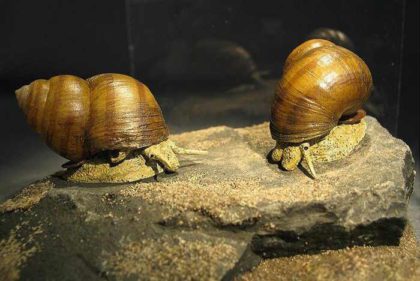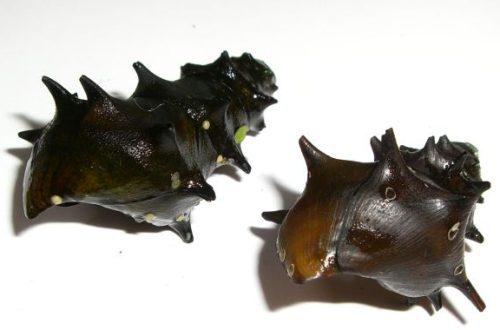
Livebearer river: content, photo, description

Many novice aquarists know almost nothing about aquarium snails. This is not very good! There are also types of predatory snails that do not tolerate other types of snails on their territory! To help you learn a little about snails, we decided to write for you about some of the types of gastropods that live in the aquarium environment.
Viviparus, he, viviparous river – This is a charming gastropod mollusk. The size, which reaches an average of 5-6 cm. Its main habitat is the stagnant reservoirs of vast Europe.
У viviparous river – a charming shell, cone-shaped, with up to 7 turns, which are smoothly wrapped. The color of the clam shell is brown or brownish-green, with dark stripes along the entire length. The bottom of the sink is equipped with a special cover that protects the livebearer from various dangers. The mollusk breathes exclusively with gills. The snail prefers soil, both at the bottom of the aquarium and on land itself. Big lover of different snags and pebbles.
Contents
Maintenance and feeding
The content is probably the most unpretentious snail. Any volume is suitable, even a 3-liter jar, the main thing is that there is enough food for the snail. There are no special requirements for water either, because in nature in ponds the water is far from clean, but as a rule, snails are kept in common aquariums and the conditions created there will be ideal for livebearers.
Like all snails, the Viviparous is an aquarium orderly, eating leftover food, detritus, dead fish, and does not touch aquarium plants. Like all aquarium inhabitants, you need to watch the snails, if you see that the snail has been lying in one place for several days, then you need to get it out and examine it, the dead livebearers, as well as other snails, pollute the water, such snails need to be removed from the aquarium.
Since the mollusk spends most of its time at the bottom, it can be fed with catfish food. As aquarists say, 50 livebearers are enough for a 10 liter aquarium.
Aquarium water quality, is not fundamental for these beauties. In nature, they live in fairly wetlands, which is why they are not picky about water. But, after these words, it does not mean that you need to litter your aquarium, and do not change the water in it at all. Its certain intended
Its certain intended
no “scavengers” – aquar clams cope with this just fine! Thanks to these “vacuum cleaners”, very little debris remains at the bottom of the aquarium. It’s just that if there is a lot of garbage, when it rots, it can cause the most acute forms of poisoning in all the inhabitants of the aquarium, or, alternatively, become the number one distributor for many types of harmful bacteria. The river livebearer does not need a special, separate feed, she eats everything that is at hand.

Viviparous breeds Often. Up to 30-40 mollusks are produced at a time for “white light”. Babies, already at birth, have a transparent, but very fragile shell-shell. But, over a period of time, these transparent shells become a natural brown color, like in adult snails.
The number of snails that should be in the aquarium is up to you! When breeding mollusks, they must be deposited in a separate place.
behavior in the aquarium. Peaceful aquarium inhabitants, can live together with other types of snails such as Melania, Fiza, etc.
Habitat
The birthplace of the Viviparous River is Europe. The mollusk lives in ponds, lakes, in any reservoirs with stagnant water and dense vegetation. The live-bearer prefers to stay on plants or in silted places of the reservoir. Appearance and coloration.
The shell of the Viviparous is rounded with a cone-shaped top, about 5 cm long and at the same time has 6-7 curls of brown-green color with black stripes. The Viviparous, like the Ampoule, has a lid that she closes in case of danger. The mollusk breathes with the help of gills. Other species can also be found in nature.
Live-bearer: Amur, Bolotnaya, Ussuri, Chased. All these species differ mainly in the structure and color of the shell. Sex characteristics. Livebearers are dioecious. Males differ from females in their head tentacles: in females, these tentacles are of the same thickness; in males, the right tentacle is greatly expanded and plays the role of a copulatory organ (Zhadin, 1952).





